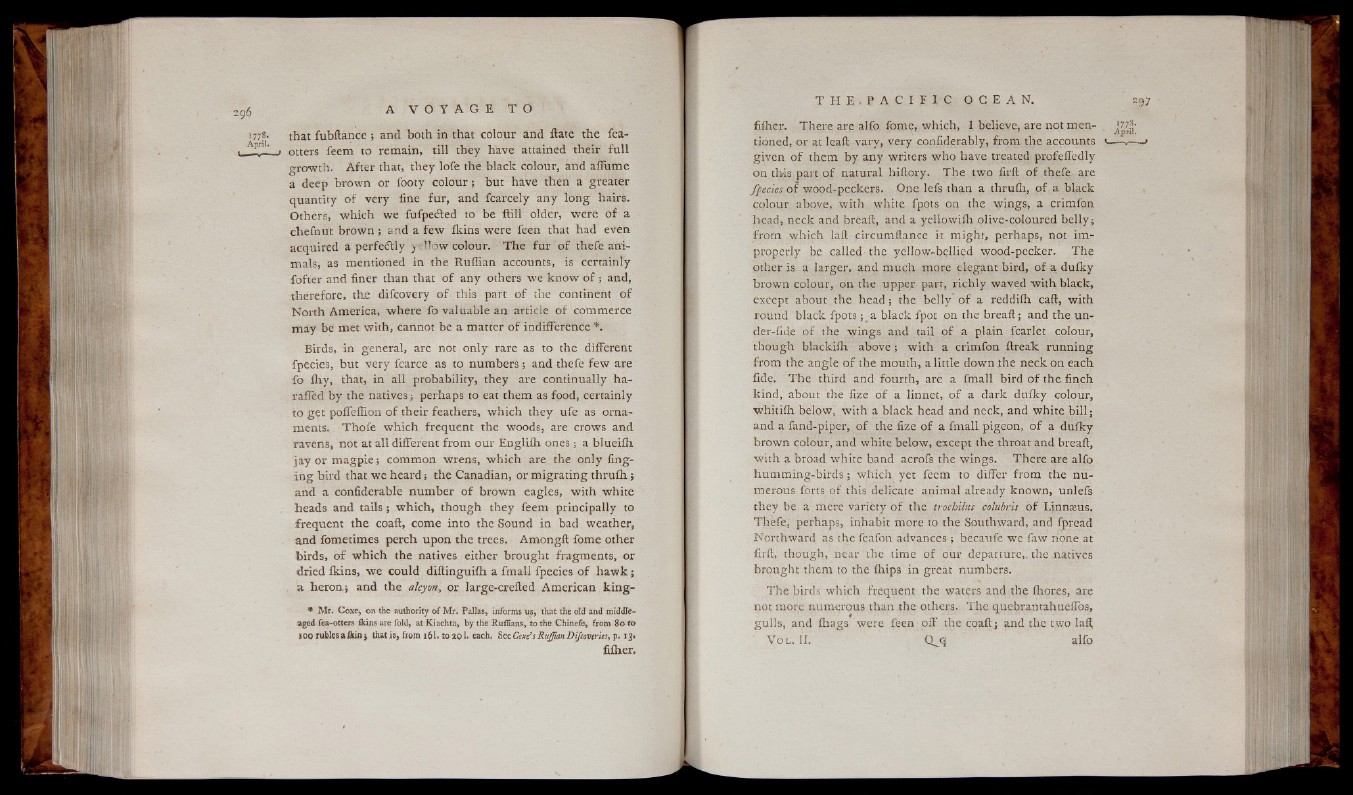
1778.
April.
R i SI
that fubftance ; and both in that colour and ftate the fea-
otters feem to remain, till they have attained their fu ll
growth. After that, they lofe the black colour, and affume
a deep brown or footy c o lo u r ; but have then a greater
quantity o f very fine fu r , and fcarcely any long hairs.
Others, which we fufpe&ed to be ftill older, were o f a
chefnut brown ; and a few ikins were feen that had even
acquired a perfectly ye llow colour. T h e fu r o f thefe animals,
as mentioned in the Ruffian accounts, is certainly
fofter and finer than that o f any others we kn ow o f ; and,
therefore, the difcovery o f this part o f the continent o f
North America, where fo valuable an article o f commerce
m a y be met with, cannot be a matter o f indifference *.
Birds, in general, are not only rare as to the different
fpecies, but ve ry fcarce as to n um b e r s ; and thefe few are
fo ihy , that, in all probability, they are continually ha-
railed by the n ative s; perhaps to eat them as food, certainly
to ge t poffeffion o f their feathers, w h ich they ufe as ornaments.
T h o fe which frequent the woods, are crows and
ravens, not at all d ifferent from our Engliih ones ; a blu e ilh
ja y or m a gp ie ; common wrens, w h ich are the only fing-
in g bird that we heard ; the Canadian, or migrating th ru fh ;
and a confiderable number o f brown eagles, with white
heads and tails ; w hich, though they feem principally to
frequent the coaft, come into the Sound in bad weather,
and fometimes perch upon the trees. Amongd fome other
birds, o f w h ich the natives either brought fragments, or
dried ikins, w e could diftinguiih a fmall fpecies o f h a w k ;
a heron; and the alcyon, or large-crefted American k in g -
* M r. Coxe, on the authority o f M r. Pallas, informs us, that the old and middle-
aged fea-otters ikins are fold, at Kiachta, by the Ruilians, to the Chine fe, from 80 to
xoo rubles a ikin 5 that is, from 16I. to 201. each, See Coxe’s RuJJian Difcovtries, p. 13«
fi flier.
fiflier. There are alfo fome, which, I believe, are not men- , j g # • - 7 . April.
tioned, or at lead vary, ve ry confiderably, from the accounts v— .---->
given o f them b y any writers who have treated profefledly
on this part o f natural hiftory. T h e two firit o f thefe are
ffecies o f wood-peckers. One lefs than a thrufh, o f a black
colour above, with white fpots on the wings, a crimfon
head, n eck and bread, and a yellowiffi olive-coloured b e lly ;
from which lad circumdance it might, perhaps, not im properly
he called the yellow-bellied wood-pecker. The
other is a larger, and much more elegant bird, o f a du ik y
brown colour, on the upper part, rich ly waved with black,
except about the h e a d ; the b e lly o f a reddifh cad, with
round black fpots ;_a black fpot on the bread; and the un-
der-fide o f the w in g 3 and tail o f a plain fcarlet colour,
though blackifh a b o v e ; with a crimfon dreak running
from the angle o f the mouth, a little down the n eck on each
fide. The third and fourth, are a fmall bird o f the finch
kind, about the fize o f a linnet, o f a dark d u ik y colour,
whitifh below, with a black head and neck, and white b ill;
and a fand-piper, o f the fize o f a fmall pigeon, o f a dufky
brown colour, and white below, except the throat and bread,
w ith a broad white band acrofs the wings. The re are alfo
hum m in g -b ird s ; w hich yet feem to differ from the numerous
forts o f this delicate animal already known, unlefs
they be a mere variety o f the trochilus colubris o f Linnaeus.
Thefe, perhaps, inhabit more to the Southward, and fpread
Northward as the feafon advances ; becaufe we faw none at
fird, though, near the time o f our departure,, the natives
brought them to the fhips in great numbers.
The birds which frequent the waters and the fhores, are
not more numerous than .the others. T he quebrantahueffos,
■ ♦ • ■ - •'
gu lls, and fhags were feen o ff the coafl; and the two laH